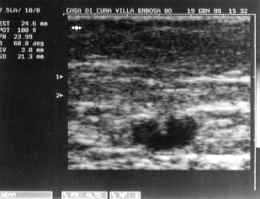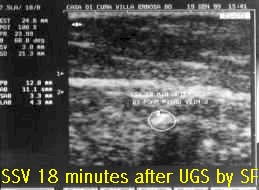PERSONAL EXPERIENCE WITH THE SCLEROSING FOAM IN DUPLEX GUIDED SCLEROTHERAPY
Cavezzi A., Frullini A. *
Vascular Unit, "Stella Maris" Clinic, S. Benedetto del Tronto (AP),ITALY, cavezzia@insinet.it
* Vascular Unit, "Villa Maria Teresa" Clinic, Florence ITALY, alef@dada.it
Duplex guided sclerotherapy (DGS) of varicose veins due to saphenous incontinence or recurrence has been recognized as a reliable way to treat this disease. Recurrence of retrograde flow in the treated vessel still represents a typical aspect of DGS in cases of large caliber axes, affected by a high hydrodynamic load. In search of an improvement of sclerotherapy possibilities, Monfreux and Cabrera have proposed the use of the sclerosing drug under the form of a foam (1)(2) made of mini-bubbles of sclerosing drug and air, or other gases. The sclerosing foam (SF) has been currently used and tested for possibilities, limits and safety of its use (1)(2)(3), resulting in an enhancement of the sclerosing power, as well as in a few possible transitory complications (scotomas, headaches, transient state of confusion). Still no clear explanations have been given for these adverse effects (mainly due to the use of the air ), but several precautions can be taken to minimize these possible reactions: the most important one is related to the quantity of SF per session, which should never exceed 3 cc, and the other precaution deals with the avoidance of the deambulation for some minutes after the injection.
The current use of SF allows to move the blood away from the treated vessel, permitting a longer and more complete contact between the drug and the vein walls. This may achieve a greater effect on the varices, with a low dose and concentration of the sclerosing liquid.
Patients and Methods
Since November 1997 we have treated nearly 150 patients by DGS with SF. The sclerosing solution has to be prepared by the use of detergent sclerosing drug only, such as polidocanol or sodium tetradecylsulphate (STS).
Monfreux's technique permits to obtain the SF from about 0,5-0,7 ml of pure sclerosing liquid, which is mixed with air bubbles in a glass syringe. The air enters into the glass syringe, by pulling its piston against the resistance opposed by the firm closure of the hole in the final truncated cone.
One or more injections have been performed each session, for a total amount of 3 cc maximum. STS (Trombovar ®, Fibro-Vein ®) mainly, or polidocanol (Atoxysclerol ®) have been used to produce the SF and DGS technique has been characterized by the transversal or longitudinal scanning to guide the injections. Alternating compression using a probe as described by Schadeck (4) or sequestration at the junction site have been performed differently by the two authors to improve the spasm (the end-point).Elastic compression has been the same as previously indicated (5).
By means of colour flow duplex imaging results have been controlled at a mid-term (average of 21 weeks ) follow-up.
Results
From November 1997 to June 1999 one hundred thirty eight consecutive patients with incompetent saphenous veins or recurrent varicose veins were included in the study . There was a total of 165 diseased axes, consisting of 77 cases of long saphenous vein, mainly, or anterior saphenous vein , 43 cases of short saphenous vein, and 45 cases of post-operative recurrences (mainly from inguinal recurrence). On average 1.8 (1 -3) treatment sessions were needed to achieve sclerosis of the veins. We have used mainly STS 3%, but STS 1% was used in 38 patients with smaller veins and low-velocity reflux and polidocanol 3-4% in 35 patients.
There were 7 completely unsuccessful cases despite 3 treatment sessions in 40 days with increasing doses, and 15 cases of early re-canalization (with reflux or retrograde flow), subsequently successfully retreated. We have obtained a total of 158 cases of stable sclerofibrosis, re-canalization with cephalad flow, or with reflux which does not transfer to the tributaries (95%), re-entering into the deep venous system via re-entry perforators. Finally the restriction of the treated trunk was evident in the vast majority of the controlled veins.
Side effects observed were one case of scotomas and one patient had temporary mental confusion (the relationship with SF is debatable, and no similar side effects occurred in the last one year-experience). No pulmonary embolism was detected and 4 cases of superficial thrombophlebitis occurred. Finally, one patient had a slight extension of the sclerothrombus , which obliterated the short saphenous vein, up to a short tract of the superficial wall of the popliteal vein (see pict.), without any related clinical signs and any pathological clinical and ultrasound findings at 6 months follow-up.
Discussion
A number of theoretical and practical conclusions, both positive and negative, can be drawn from an analysis of our experience involving the use of SF in the DGS of varicose veins.
On the positive side, sclerosis is faster and a smaller quantity of sclerosing liquid is needed for each treatment session. There is also a better "mapping" of the treated vessels, thanks to the echo-contrast effect of the SF itself and a more complete, simultaneous treatment of the saphenous collaterals. In addition there is a significantly lengthy spasm and sclerosing action, especially where two injections are performed in the same axis. Re-sclerosis is very powerful, due to the invasion of SF just into the residual lumen, easily moving away the blood. Extravasation, due to chemical dilution and its easy visualization, is effectively less dangerous.
Negative aspects include a) the above mentioned possible side-effects needing further comprehension, b) the increased time for the preparation of the SF and prolongation of the supine posture of the patient after the treatment session, c) finally, there is the need to use glass syringes, creating additional problems with sterilization and possible "psychologic resistance" by the patient (and the physician himself..).
The short follow-up period does not allow us to express definitive opinions about the durability of DGS by SF, but this new method represents a valuable enhancement of sclerotherapy for varicose veins. The sclerosing liquid dose per session (practically always less than 0,8 ml ) is remarkably low and the short term results with SF seem comparable or even better than those obtained with DGS by liquid drug.
Future improvements of this method appear quite close to being realized, providing a likely enhancement of sclerotherapy by sclerosing foam and an effective use of this new treatment perspective.
REFERENCES
1) Monfreux A. Traitement sclérosant des troncs saphènies et leurs collatérales de gros calibre par la méthode MUS Phlébologie 1997;50(3):351-3
2) Cabrera Garrido J.R., Cabrera Garcia-Olmedo J.R., Garcia-Olmedo Dominguez M.A - Elargissement des limites de la schlérothérapie:noveaux produits sclérosants Phlébologie 1997; 50(2):181-8
3) Henriet J.P. un an de pratique quotidienne de la sclérothérapie (veines reticulaires et téleangiectasies) par mousse de polidocanol: faisabilité, résultats, complications Phlébologie 1997; 50(3): 355-60
4) Schadeck M. Ultrasound guided sclerotherapy, pag.115-28, in Duplex and Phlebology, Gnocchi Ed., Naples 1994
5) Cavezzi A. La escleroterapia ecoguiada de las varices y el papel de la compresion: experiencia personal, Rev. Panamericana de Flebologia y Linfologia, 1997; 27: 39-46
















